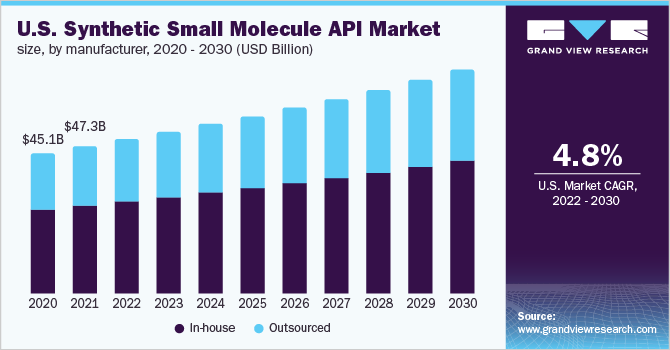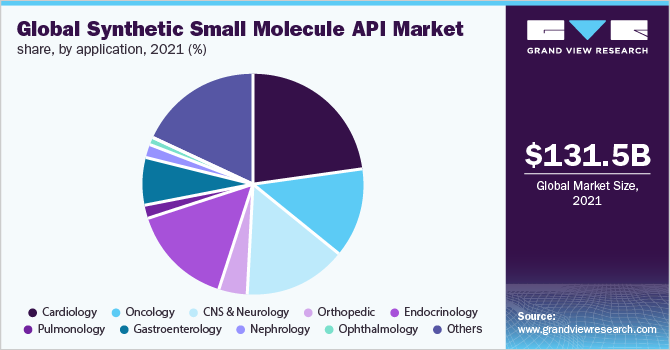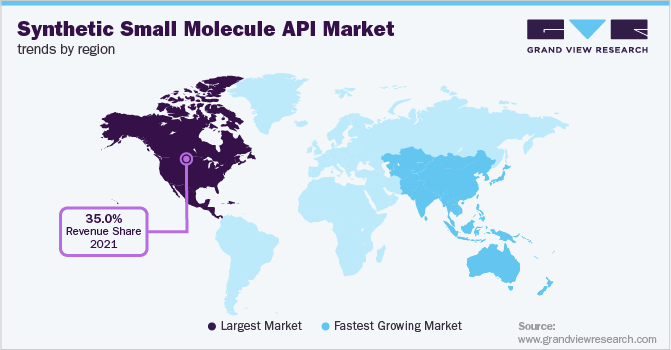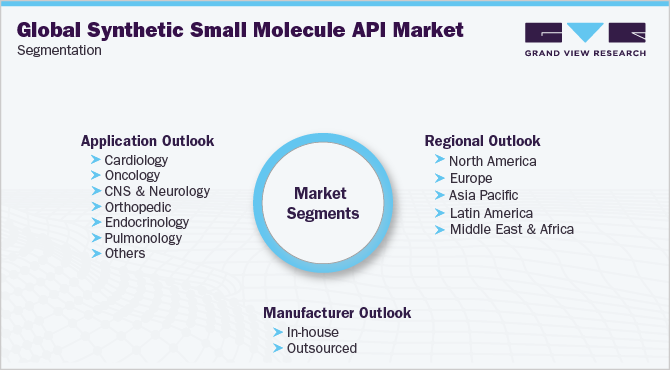- Home
- »
- Pharmaceuticals
- »
-
Synthetic Small Molecule API Market Size Report, 2022-2030GVR Report cover
![Synthetic Small Molecule API Market Size, Share & Trends Report]()
Synthetic Small Molecule API Market Size, Share & Trends Analysis Report By Manufacturer (In-house, Outsourced), By Application (Cardiology, Oncology), By Region, And Segment Forecasts, 2022 - 2030
- Report ID: GVR-4-68039-976-3
- Number of Report Pages: 90
- Format: PDF, Horizon Databook
- Historical Range: 2018 - 2020
- Forecast Period: 2022 - 2030
- Industry: Healthcare
Report Overview
The global synthetic small molecule API market size was valued at USD 131.55 billion in 2021 and is expected to expand at a compound annual growth rate (CAGR) of 5.73% from 2022 to 2030. The growth of the market is attributed to factors such as the growing demand for small molecules API and an increased outsourcing trend in the market. Moreover, the expiry of patents for leading molecules facilitates the entry of new players into the market. The demand for raw materials such as API for low-cost production of drugs further propels growth.

The COVID-19 outbreak has facilitated the growth of the market by encouraging players to geographically diversify their businesses to avoid shortages. The demand for APIs eventually grew during the pandemic owing to the impaired functioning of the respiratory system in patients suffering from the infection. COVID-19 is further propelling the investigation of small molecule products. Moreover, studies for repurposing existing small molecule drugs are ongoing for the treatment of SARS-CoV-2 infection.
One of the major drivers of the market is the high demand for generic drugs. APIs for generic drugs generate high revenue for chemical and synthetic API manufacturing companies. This is creating a wide opportunity for CDMOs working in the segment. The opportunity in the synthetic API market becomes even more lucrative for CDMOs owing to the increase in outsourcing trend as companies want to improve profitability by reducing the cost of production.
Furthermore, the growth of the market is attributed to the ease of production associated with small molecules and high effectiveness possessed by the molecules. Small molecule API represents around 78% of the total share representing the majority of medicines that we consume. This escalates the demand for finished products and formulation of API, further propelling the demand for synthetic small molecule API.
However, production requires sophisticated infrastructure, making it a capital-intensive market. In addition, stringent safety regulations need to be followed during the production process, which may hinder market growth. Manufacturers consider API production difficult because of the need for high investments against fewer returns in the initial stages as new and expensive drugs face slower acceptance.
Manufacturer Insights
The in-house segment dominated the overall market with a revenue share of over 60.0% in 2021. The growth of the segment can be attributed to manufacturers aiming to lower the reliance on CDMOs and suppliers for raw materials and rather focusing on developing their own API. For instance, in April 2021, Lonza launched a new small-molecule manufacturing complexat its Visp, Switzerland, site that would enhance future small-molecule technologies expansion.
The outsourced segment is expected to grow at the fastest rate over the forecast period owing to the increasing shift of manufacturing companies towards contract research and development organizations for the production of API commercially. For instance, in 2021, Curia, a CDMO invested more than USD 35 million in the expansion of its commercial manufacturing capacity at its Rensselaer, New York facility. Moreover, the increasing demand for the requirement of complex manufacturing processes further increases the growth of the segment.
Application Insights
The cardiology segment led the market with a revenue share of over 20.0% in 2021. This is attributed to the increasing prevalence of target diseases worldwide owing to changes in food habits and lifestyles. Moreover, the market is driven by increasing implementation of treatment for cardiovascular conditions. Hypertension and atrial fibrillation drug sales account for one of the highest shares in the CVD drugs and API market. According to the WHO in 2021, around 1.28 billion adults are estimated to have hypertension, which accounts for a larger share of drug sales.

The oncology segment is projected to grow at the fastest rate over the forecast period. The increasing global prevalence of cancer is a key factor driving this market. Moreover, an increase in oncology research and development is resulting in the launch of a number of novel drugs that further boost oncology adoption, which, in turn, fuels the growth of the oncology segment. For instance, in 2021, 9 novel drugs were launched, which were developed from small molecule API for the treatment of various forms of cancer.
Regional Insights
North America accounted for the largest revenue share of over 35.0% in 2021. This can be attributed to the increasing support from the government with favorable initiatives, coupled with the increased interest of players in the development of novel products in the region. For instance, in September 2021, AbbVie announced the U.S. FDA approval of Qulipta (atogepant) for episodic migraine in adults. The medication is the first and only oral antagonist of the calcitonin gene-related peptide receptor. Moreover, the government in this region is becoming increasingly supportive in terms of regulation of API production, which further has reduced the dependence of the region on Asian manufacturers.

Asia Pacific is estimated to be the fastest-growing segment over the forecast period due to the dependence of pharmaceutical manufacturers for API production on China and India, increasing focus on the development of less complex molecules that can be produced in bulk, and involvement in supplying API globally at a low cost. Moreover, increasing government support for investments in API businesses is leading to growth.
Key Companies & Market Share Insights
Key players operating in the market are focusing on partnerships, strategic collaborations, and geographical expansion in emerging and economically favorable regions. For Instance, in 2021, Rhizen Pharmaceuticals announced the FDA approval of PI3K-delta inhibitor, a novel drugUmbralisib, for the treatment of adults with refractory and relapsed marginal zone lymphoma and follicular lymphoma. Some prominent players in the global synthetic small molecule API market include:
-
Bristol-Myers Squibb Company
-
Cipla, Inc.
-
Boehringer Ingelheim International GmbH
-
Merck & Co., Inc.
-
AbbVie, Inc.
-
Aurobindo Pharma
-
Sun Pharmaceutical Industries Ltd.
-
Teva Pharmaceutical Industries Ltd.
-
Albemarle Corporation
-
Viatris Inc.
-
Dr. Reddy’s Laboratories Ltd.
Synthetic Small Molecule API Market Report Scope
Report Attribute
Details
Market size value in 2022
USD 139.05 billion
Revenue forecast in 2030
USD 217.17 billion
Growth rate
CAGR of 5.73% from 2022 to 2030
Base year for estimation
2021
Historical data
2018 - 2020
Forecast period
2022 - 2030
Quantitative units
Revenue in USD billion and CAGR from 2022 to 2030
Report coverage
Revenue forecast, company ranking, competitive landscape, growth factors, and trends
Segments covered
Manufacturer, application, region
Regional scope
North America; Europe; Asia Pacific; Latin America; MEA
Country scope
U.S.; Canada; Germany; U.K.; France; Italy; Spain; China; Japan; India; Australia; South Korea; Brazil; Mexico; Argentina; South Africa; Saudi Arabia; UAE;
Key companies profiled
Merck & Co., Inc.; AbbVie, Inc.; Bristol-Myers Squibb Company; Boehringer Ingelheim International GmbH; Cipla, Inc.; Teva Pharmaceutical Industries Ltd.
Customization scope
Free report customization (equivalent up to 8 analyst’s working days) with purchase. Addition or alteration to country, regional & segment scope.
Pricing and purchase options
Avail customized purchase options to meet your exact research needs. Explore purchase options
Global Synthetic Small Molecule API Market Segmentation
This report forecasts revenue growth at the global, regional, and country levels and provides an analysis of the latest industry trends and opportunities in each of the sub-segments from 2018 to 2030. For the purpose of this study, Grand View Research has segmented the global synthetic small molecule API market report on the basis of manufacturer, application, and region:

-
Manufacturer Outlook (Revenue, USD Billion, 2018 - 2030)
-
In-house
-
Outsourced
-
-
Application Outlook (Revenue, USD Billion, 2018 - 2030)
-
Cardiology
-
Oncology
-
CNS and Neurology
-
Orthopedic
-
Endocrinology
-
Pulmonology
-
Gastroenterology
-
Nephrology
-
Ophthalmology
-
Others
-
-
Regional Outlook (Revenue, USD Billion, 2018 - 2030)
-
North America
-
U.S.
-
Canada
-
-
Europe
-
U.K.
-
Germany
-
France
-
Spain
-
Italy
-
-
Asia Pacific
-
Japan
-
China
-
India
-
South Korea
-
Australia
-
-
Latin America
-
Brazil
-
Mexico
-
Argentina
-
-
Middle East & Africa
-
South Africa
-
Saudi Arabia
-
UAE
-
-
Frequently Asked Questions About This Report
b. The global synthetic small molecule API market size was estimated at USD 131.55 billion in 2021 and is expected to reach USD 139.05 billion in 2022.
b. The global synthetic small molecule API market is expected to grow at a compound annual growth rate of 5.73% from 2022 to 2030 to reach USD 217.17 billion by 2030.
b. The cardiology segment dominated the market with a revenue share of 22.58% in 2021. This is attributable to the increasing implementation of treatment for cardiovascular conditions. Hypertension and atrial fibrillation drug sales account for one of the highest shares in the CVD drugs and API market.
b. Some key players operating in the synthetic small molecule API market include Merck & Co., Inc., AbbVie, Inc., Bristol-Myers Squibb Company, Boehringer Ingelheim International GmbH, Cipla, Inc., and Teva Pharmaceutical Industries Ltd.
b. Key factors that are driving the market growth include the growing demand for small molecules API, an increased outsourcing trend in the market, expiry of patent for leading molecules facilitate the entry of new players into the market and the increasing demand for raw materials like API for low-cost production of drugs.
Share this report with your colleague or friend.
![gvr icn]()
NEED A CUSTOM REPORT?
We can customize every report - free of charge - including purchasing stand-alone sections or country-level reports, as well as offer affordable discounts for start-ups & universities. Contact us now
![Certified Icon]()
We are GDPR and CCPA compliant! Your transaction & personal information is safe and secure. For more details, please read our privacy policy.
We are committed towards customer satisfaction, and quality service.
"The quality of research they have done for us has been excellent."





